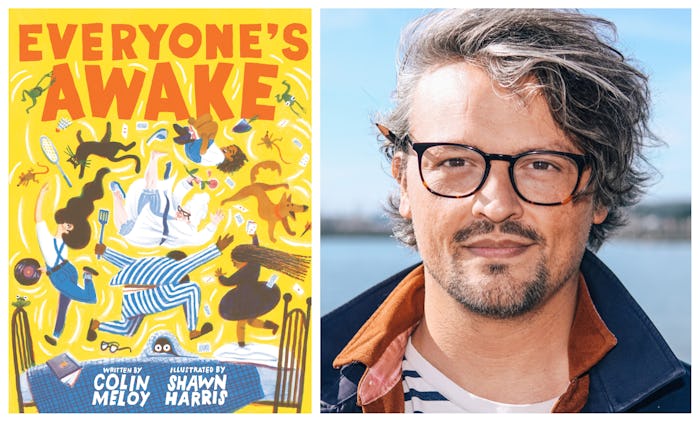Life

Shawn Harris On How To *Make* A Children's Book
The first thing you will notice on holding a copy of Everyone's Awake, the new children's book written by Colin Meloy and illustrated by Shawn Harris, is the brightness. "If you read the book in daylight, it almost hurts your eyes to see that yellow," says Harris, who has previously created the art for numerous bands, and collaborated on Her Right Foot and What Can A Citizen Do with Dave Eggers.
Most children's books today are printed using the CMYK process, which converts a digital file into colors that are created through a programmed mix of cyan, magenta, yellow, and black ink — the same colors your workplace Xerox cranks out. That wasn't what Harris had in mind.
"I was looking at Nobrow's [Press] stuff," he explains, referencing a specialty British publisher, "they do great spot colors where they aren't using normal CMYK, so that was sort of in my brain." Flipping through Pantone books, he saw a neon yellow process color, and "it looked like a light flipped on inside of the paper. I was like, we have to use that. We have to use that."
The ink mixes on the page when you print them, so every book is, in a way, a new piece of art.
Having seen a literal lightbulb go off, he set to work on the illustrations, and then "preseparated them by hand," Harris explains, glossing over the most interesting and challenging part of the process. Each vivid spread in the book was created as preseparated art, in which the artist creates individual pieces of art for each color that will be used. The originals were all done in black and white, and he then used a lightbox to trace three more drawings of the same scene onto paper — one for each process color.
"One must be a masochist to do color separations," Ariane Dewey says in a paper somewhere in the University of Minnesota's archives, and "also have endless patience."
This is the art Harris is helping explain for us.
Above is one of the color-separated pieces of art Harris created to print a single page of the book. Because each piece differed subtly from the original (human error and so on), and he was working in black and white, he didn't know exactly how the final product would look until it went off to the printer. "The ink mixes on the page when you print them, so every book is, in a way, a new piece of art," says Harris of the process.
He was able to "mock up a preview" on his computer, but "not until they were printed did we actually see what the colors blended [looked] like."
"That was a fun surprise to have the look of the book be that delayed," he recalls, "like oh, I hope this works."
In the meantime, he printed versions of each artwork onto transparency sheets in an approximation of the final color, to see how they would look in their final form. Above, you can see a transparency sheet with the blue layer printed on it.
And above is one of the neon yellow layer, with blue and red transparencies visible on the table.
When he layered them together, Harris had a sense of what the finished book would look like. Again, this is a masochistic way to go about making a book. And doesn't it look incredible? Next is the finished product, a page from the printed book scanned into digital form to come full circle.
As Harris points out, the artform has enjoyed a resurgence in recent years. Any book with the telltale overlap of printed colors that reminds you of something from mid-century was likely created through preseparated art, including a few of Harris's favorites, like Hello, Mr. Dodo! by British artist Nicholas John Frith, and German silkscreen artist Blexbolex's People. Think also of the art of Dr. Seuss and of P.D. Eastman books.
Hello, Mr. Dodo! uses four colors, as you can see: aqua, a primary yellow, tangerine, and black.
The green, purple, and brown in Blexbelox's People result from the yellow, blue, and pink layers mixing on the printed page (Blexbolex incidentally has had many works printed by Nobrow Press). Mentally deconstructing the colors is nothing if not exacting, but Harris doesn't like taking the easy route: he chose to do paper cuts for the art in What Can A Citizen Do.
Harris credits his publisher with trusting him on his approach, which has clearly paid its dividends. "We did use black for the text, but the art is all three colors," in Everybody's Awake, he says. "So I was like, I'm saving you the color of one ink."
Everyone's Awake is out now from Chronicle Books.
Read Romper's interview with Colin Meloy and Shawn Harris here.
This article was originally published on